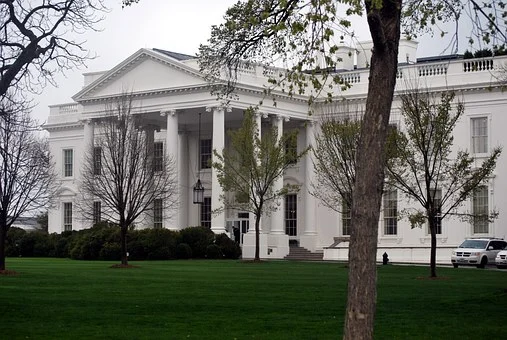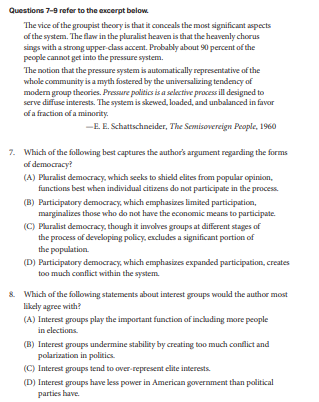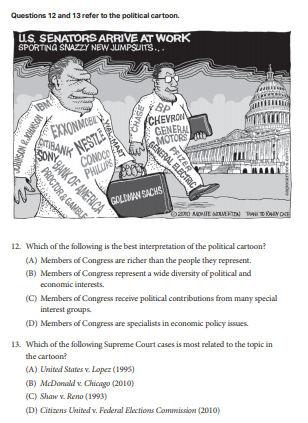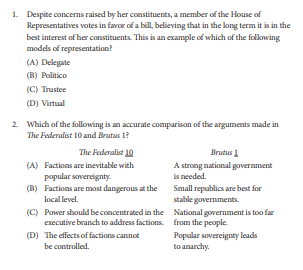AP US Government Multiple Choice Help (MCQ)
5 min read•july 11, 2024
Akhilesh Shivaramakrishnan
AP US Government 👩🏾⚖️
240 resourcesIntro
An Overview 🔎
- There are 55 multiple-choice questions on the AP US Government exam ✍
- You have 80 minutes to answer them 🕐
- This works out to be about 1 and a half minutes per question! This is a decent amount of time for each question, so take your time!
- The multiple-choice section is worth 50% of your overall AP score 🌓
- The other 50% is the free-response section (4 questions).
- There are no deductions. You only get points for the questions you get correct. This means there's no difference between a question that's left blank and a question answered incorrectly!
- Don't leave questions blank ✨
- About half of the questions will have supporting stimulus 📷 (some sort of graph, chart, passage, or image) and half will be standalone questions.

A view of the White House, the home of the President of the United States. Image Courtesy of Pixabay
Skills Assessed on the MC Section
- 📝 Skill 1 Concept Application—applying political concepts in hypothetical and real-life contexts
- ⚖ Skill 2 Supreme Court Application—apply Supreme Court decisions in real-life contexts
- 📈 Skill 3 Data Analysis—analyze and interpret graphs, tables, charts, infographics
- 🔎 Skill 4 Source Analysis—interpret and analyze foundational documents
Types of Questions
- 📈 Quantitative Analysis (5 sets of questions with 2-3 questions per set).
- These questions will appear in sets and will have some sort of stimulus to look at and interpret.
- The stimuli for the questions will include at least one of the following: line graphs, charts, tables, maps, infographics 📊
- 📃 Text Based Analysis (2 sets of questions with 3-4 questions per set).
- These questions will appear in sets and will have some sort of stimulus for you to read and analyze.
- 1 set will include a foundational document as a stimulus 📝
- 1 set will include a primary or secondary text-based source as a stimulus (not a foundational document, but another relevant text) 📰
- 📷 Visual Source Analysis (3 sets of questions with 2 questions per set).
- These questions will appear in sets and will have some visual stimulus for you to analyze.
- The stimuli for the questions will include at least one of the following: map, image, political cartoon, or an infographic 🖼
- ✍ Standalone Questions (around 30 questions)
- These questions will NOT have stimulus and will test your knowledge of various elements of the course.

You might have to know some of the required SCOTUS cases for the multiple-choice section! Image Courtesy of Pixabay
Multiple Choice Tips
- 📈 Quantitative Analysis
- Practice reading graphs and other models of data representation throughout the year. A great source to use is FiveThirtyEight, which has tons of politics-centered graphics 📊
- Use the content you know to help guide you when analyzing a chart or graph. The graphic is normally only there to help you get started 🔎
- 📃📷 Text Based and Visual Analysis
- Consider the historical context. Who was the author or artist? When was it written or drawn? What was happening during that time?
- Try to connect any visual stimuli to a specific piece of content. How does the visual contribute to that?
- Underline the important information or political concepts you can pick out. These might help you find the right answer!
- ✍ Standalone Questions
- These will test your understanding of either SCOTUS cases ⚖ or applying concepts you've learned to various contexts.
- Like all MC questions, remember to eliminate answers you know are wrong right off the bat! Use any of the above strategies relevant to the question.
💡 Do you want a more in-depth guide that will help you do amazing on the multiple-choice section? Check out this AP US Government Multiple Choice resource we've put together!
Sample Questions
📈 Quantitative Analysis

Sample quantitative analysis questions, courtesy of College Board CED for AP US Government
& Politic
s.
Text Based Analysis

Sample text based analysis questions, courtesy of College Board CED for AP US Government & Politics.
Visual Analysis

Sample visual analysis questions, courtesy of College Board CED for AP US Government & Politics.
Standalone Questions

Sample standalone MC questions, courtesy of College Board CED for AP US Government & Politics.
In Closing

Fiveable
Resources
© 2025 Fiveable Inc. All rights reserved.